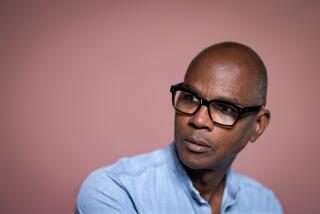Black Hole
- Share via
When I was younger, and poorer, I used to take pride in my aesthetic separatism. Art was the stuff I put on walls (even if I could afford only unframed posters), and useful objects (white dinner plates from the old Akron import stores, for example) were purposefully unadorned. I adopted a similar policy for art books; I bought only small paperbacks with negligible or nonexistent illustrations. The idea in both cases was to avoid shortchanging art, to keep from having to look at it represented in diluted, miniaturized form in places (under my Salisbury steak or next to columns of type) where it seemed relegated to mere accoutrement or storytelling. Over the years, I gradually relented, mostly because I acquired more and more discretionary income with which to indulge in craftspeople’s crockery and high-end publishers’ coffeetable art books. Besides, such books didn’t seem to be the equal of really repulsive vices like handguns and sport utility vehicles. Now, however, I’m considering a return to the purity of penury.
The occasion for this rethinking is, I’m sorry to say, the fancy new catalogue raisonne of the works on canvas of the American abstract painter Mark Rothko (1903-70). “Sorry to say” because this foot-square, 2-inch-thick, 10-pound boxed volume is, in some respects, a welcome development: it’s needed, it’s serious and it’s well-produced. Rothko emigrated from Russia to Portland, Ore., when he was 10, and later went east to attend Yale University (briefly) before immersing himself in New York and modern art. He eventually became a painter of fascinatingly austere color-clouds. He also committed suicide. Those two aspects of Rothko’s life--plus the installation of some very big, very late, very dark Rothkos in a custom-built ecumenical chapel in Houston--have made him the posthumous subject of endless and often tendentious spiritualizing by art critics who like to waft upward, toward the higher astral planes. David Anfam’s tireless research partially rescues Rothko’s work from these quasi-religionists. By reproducing every painting in color and supplying complete specifications for each, in chronological order, Anfam gives the reader a better sense of the slow, visceral struggle that is any great artist’s path to his or her best work. And Anfam’s meticulous unearthing of nearly all of Rothko’s literary and art historical sources for his imagery (or lack of imagery) reveals the contest between inclusiveness (that is, acknowledging the huge and multifarious culture of the human race) and exclusiveness (getting down to visual essentials) that was always a part of Rothko’s work.
The trouble is that the writing in “Mark Rothko: The Works on Canvas” is tedious. That’s surprising, given that Anfam is a regular contributor to the Burlington Magazine and author of a couple of books on Abstract Expressionism and “Mark Rothko: The Chapel Commission.” It’s not that he doesn’t make sense; it’s just that he makes the reader labor unnecessarily. Take this rather typical passage:
“By the mid-1930s, the logistics of the gaze infiltrate the work. They suggest inwardness and events beyond the frame. The shocked mien in ‘Untitled [Two Nudes] (cat. no. 50)’ implies an unseen transgressor; in another canvas (cat. no. 52), two stares lead in opposite directions out of the picture, a situation that is thematized in the transfixed audience of ‘Movie Palace’ (cat. no. 64). The result is to evoke an eerie condition of de-centering because few of the acts of looking have a visible object.”
What Anfam seems to be saying is that the people depicted in some of Rothko’s painting from his pre-abstract period gaze out of the frame and it looks a little eerie. But to have the dry “logistics of the gaze” “infiltrate” paintings is eerie too. To have a disembodied “mien” and physically sourceless “stares” as sentence subjects is even eerier. And what “thematized” could mean--other than a commercial editorial service, “One-Hour Thematizing, done entirely on the premises”--is a complete mystery. Almost every paragraph of Anfam’s three main essays, “The Early Years,” “The Years of Transition” and “The Classic Years,” is similarly potholed.
Maybe if Anfam’s prose weren’t so infelicitous, I wouldn’t have noticed once again, and so starkly, the drawbacks of large expensive art books. They’re not all that easy to hold in the lap; their wide pages of text are hard to read, and putting them back in their boxes demands a wrist powerful enough for an Expressionist to envy. And there’s something a bit incongruous about postcard-size reproductions of paintings that Rothko said he made so large in real life because he wanted them to be intimate experiences for the viewer. All this said, Anfam’s Rothko book is a necessity. For art scholars, that is, and those with enough discretionary income to honor the fact that “Mark Rothko: The Works on Canvas” looks impressive on the shelf.
More to Read
The biggest entertainment stories
Get our big stories about Hollywood, film, television, music, arts, culture and more right in your inbox as soon as they publish.
You may occasionally receive promotional content from the Los Angeles Times.










